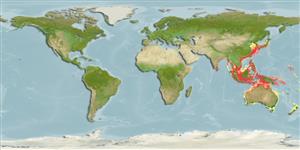Craspidaster hesperus (Müller & Troschel, 1840)
| Native range | All suitable habitat | Point map | Year 2050 |

|
| This map was computer-generated and has not yet been reviewed. |
| Craspidaster hesperus AquaMaps Data sources: GBIF OBIS |
Envoyez vos Photos
Images Google |
No photo available for this species.No drawings available for Astropectinidae.
Images Google |
No photo available for this species.
Classification / Names Common names | Synonyms | CoL | ITIS | WoRMS
Asteroidea | Paxillosida | Astropectinidae
Environment: milieu / climate zone / depth range / distribution range Écologie
; profondeur 2 - 195 m (Ref. 81020). Subtropical
Distribution Pays | Zones FAO | Écosystèmes | Occurrences | Introductions
Indo-West Pacific: Bay of Bengal, Japan to the Philippines.
Length at first maturity / Taille / Poids / Âge
Maturity: Lm ? range ? - ? cm
Life cycle and mating behavior Maturité | Reproduction | Frai | Œufs | Fécondité | Larves
Members of the class Asteroidea exhibit both asexual (regeneration and clonal) and sexual (gonochoric) means of reproduction. Life cycle: Embryos hatch into planktonic larvae and later metamorphose into pentamorous juveniles which develop into young sea stars with stubby arms.
Référence principale
Références | Coordinateur | Collaborateurs
Chao, S.-M. 2000. (Ref. 77937)
Statut dans la liste rouge de l'IUCN (Ref. 130435: Version 2024-1)
statut CITES (Ref. 108899)
Not Evaluated
CMS (Ref. 116361)
Not Evaluated
Menace pour l'homme
Utilisations par l'homme
| FishSource |
Outils
Plus d'informations
Trophic Ecology
Éléments du régime alimentaire
Régime alimentaire
Consommation alimentaire
Ration
Prédateurs
Régime alimentaire
Consommation alimentaire
Ration
Prédateurs
Ecology
Population dynamics
Croissance
Taille/Âge
Longueur-poids
Longueur-longueur
Fréquences de longueurs
Mass conversion
Recrutement
Abondance
Taille/Âge
Longueur-poids
Longueur-longueur
Fréquences de longueurs
Mass conversion
Recrutement
Abondance
Life cycle
Reproduction
Maturité
Fécondité
Frai
Œufs
Développement de l'œuf
Larves
Dynamique des populations larvaires
Maturité
Fécondité
Frai
Œufs
Développement de l'œuf
Larves
Dynamique des populations larvaires
Distribution
Human Related
Profil d'aquaculture
Stamps, Coins Misc.
Stamps, Coins Misc.
Outreach
Taxonomy
References
Sources Internet
BHL | BOLD Systems | CISTI | DiscoverLife | FAO(Publication : search) | Fishipedia | GenBank (genome, nucleotide) | GloBI | Gomexsi | Google Books | Google Scholar | Google | PubMed | Arbre de Vie | Wikipedia (Go, chercher) | Zoological Record
Estimates based on models
Preferred temperature
(Ref. 115969): 17.5 - 28.4, mean 27.2 (based on 973 cells).


